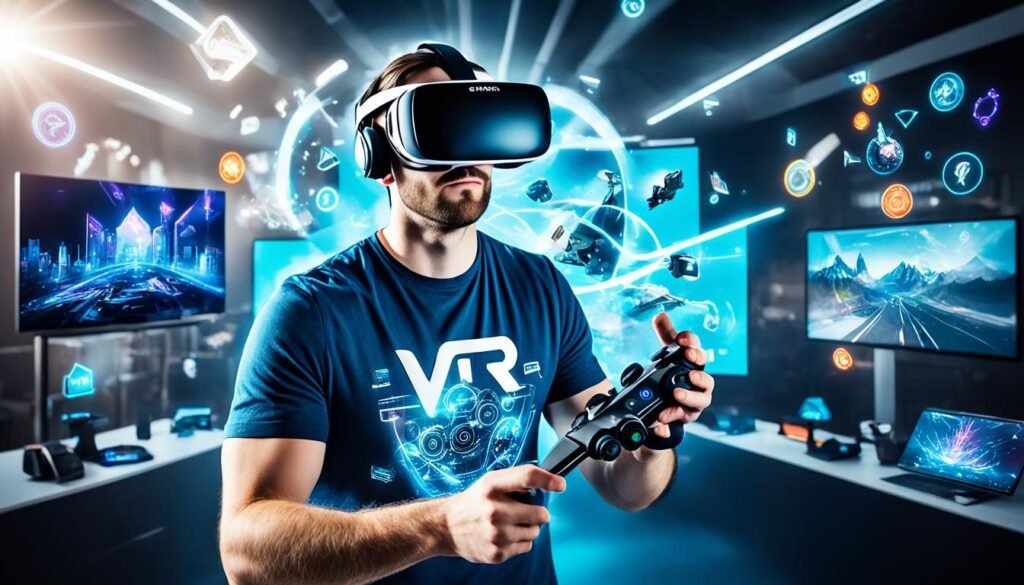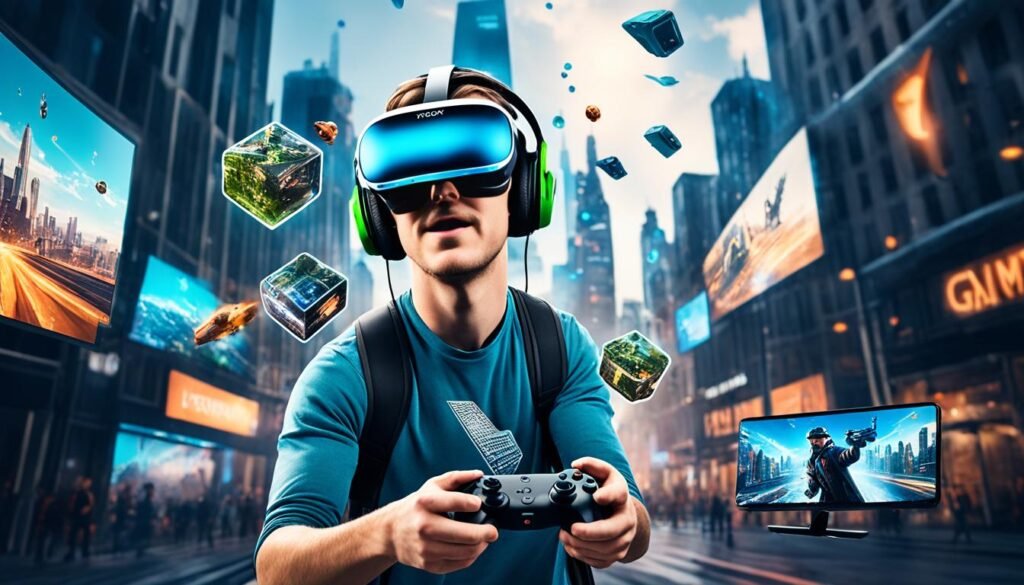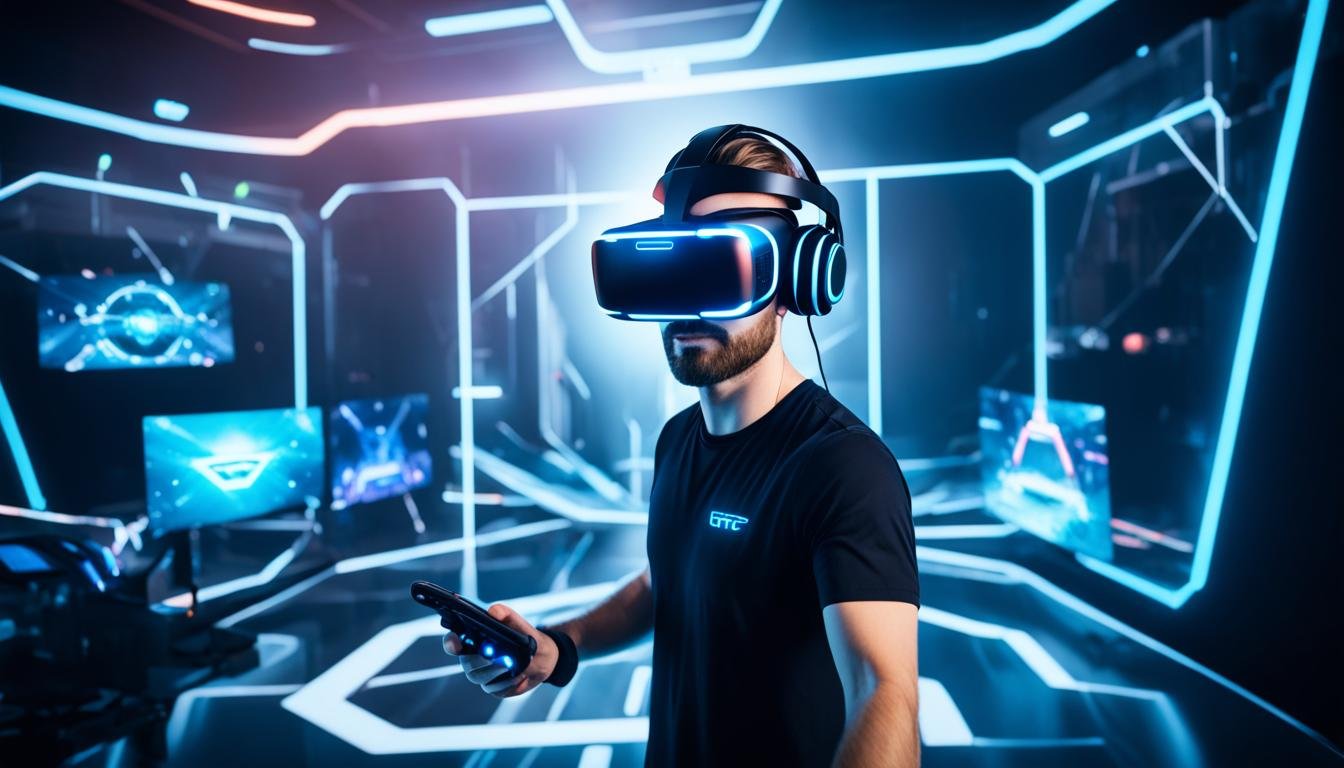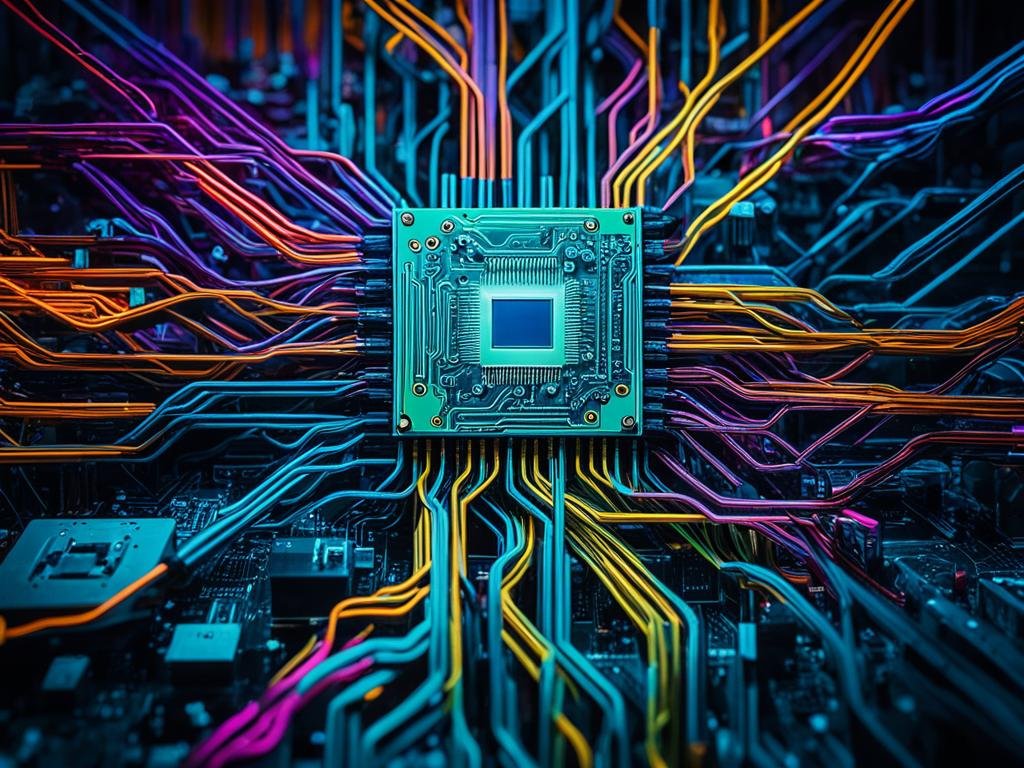Welcome to the immersive revolution! In the world of gaming, exciting advancements in technology have paved the way for new and extraordinary experiences. Augmented Reality (AR) and Virtual Reality (VR) are at the forefront of this revolution, transporting players to virtual worlds and enhancing their gaming encounters like never before.
AR takes gaming to the next level by overlaying digital elements onto the real world, blurring the lines between reality and fantasy. VR, on the other hand, transports players into fully digital environments, creating a sense of complete immersion. Together, these technologies are redefining what it means to be a gamer, providing unparalleled levels of interactivity, realism, and excitement.
In this article, we will explore the foundational concepts of AR and VR, their impact on the gaming industry, and the technological advancements that are shaping the future of gaming. Get ready to embark on a journey through the immersive realms of AR and VR, and discover the incredible possibilities that await.
Key Takeaways:
- AR and VR are revolutionizing the gaming industry, providing immersive and interactive experiences for players.
- AR overlays digital elements onto the real world, enhancing what we see, hear, and feel, while VR creates fully digital environments that transport players to different worlds.
- AR and VR work together to create innovative and immersive gaming experiences, enhancing gameplay and interactivity.
- The integration of AR and VR technologies into gaming platforms has transformed the gaming landscape, offering unique and captivating experiences.
- The economics of AR and VR in gaming include market adoption, development costs, and financial considerations for both developers and consumers.
Understanding AR and VR: Foundations of an Immersive Reality
AR and VR are two revolutionary technologies that have transformed the way we experience the world around us. Both augmented reality (AR) and virtual reality (VR) create immersive digital environments, but they do so in different ways. To truly grasp the power of AR and VR, it’s essential to understand their definitions and origins, as well as their complementary roles in the gaming industry.
Defining Augmented Reality and Virtual Reality
Let’s start by breaking down the concepts of AR and VR. Augmented reality involves overlaying digital elements onto the real world, enhancing our perception of reality. Through AR, we can experience the physical world with additional digital information, enriching our senses and altering our interactions with the environment.
On the other hand, virtual reality immerses users in a completely digital environment that simulates reality. By wearing a VR headset, users are transported to virtual worlds, where they can interact with and explore various scenarios and experiences.
The Early Days: From Science Fiction to Reality
Although AR and VR may seem like cutting-edge technologies, their origins can be traced back to early science fiction and research endeavors. The notion of augmenting reality with digital information has been explored in literature and films since the mid-20th century.
VR, too, has a rich history, with early attempts to create immersive virtual environments dating to the 1960s. Through decades of technological advancements and research breakthroughs, AR and VR have finally made their way into our daily lives.
AR and VR: Complementary Technologies in Gaming
While AR and VR are distinct technologies, they often go hand in hand in the gaming industry. AR can enhance the gaming experience by integrating digital elements into the player’s real-world environment. Imagine battling virtual enemies in your living room or solving puzzles on your own tabletop.
VR, on the other hand, transports gamers to entirely virtual worlds, offering them the opportunity to step into the shoes of their favorite characters and explore fantastical realms. The combination of AR and VR opens up a new realm of possibilities for immersive and interactive gaming experiences.
By merging augmented and virtual realities, developers can create games that seamlessly blend physical and digital elements, offering players unique and captivating experiences. Whether it’s through the use of AR glasses or VR headsets, these technologies are pushing the boundaries of what is possible in gaming.
The Pioneering Role of Augmented Reality (AR) and Virtual Reality (VR) in Gaming
Augmented Reality (AR) and Virtual Reality (VR) have revolutionized the gaming industry by offering unique and immersive experiences to players. These cutting-edge technologies have transformed the gaming landscape, integrating AR and VR into gaming platforms and pushing the boundaries of what is possible in interactive entertainment.
The integration of AR into gaming allows for the overlay of digital content onto the real world, creating an augmented experience that enhances the player’s perception. Through AR development, game developers can merge the digital and physical realms, providing gamers with interactive and engaging gameplay.
On the other hand, VR technology transports players to fully digital environments, immersing them in virtual worlds. By wearing VR headsets, players can explore virtual realms, interact with objects, and engage in thrilling experiences that feel incredibly real.
Both AR and VR have led to the development of exciting applications in the gaming industry. AR applications enhance gameplay by incorporating real-world elements into the gaming experience, while VR experiences offer immersive storytelling and unparalleled interactions.
AR and VR have had a profound impact on the gaming industry, providing gamers with novel experiences and pushing the boundaries of what can be achieved in interactive entertainment. The pioneering role of AR and VR is evident in the integration of these technologies into gaming platforms, the development of innovative AR applications, and the creation of immersive VR experiences that transport players to new worlds.
Breaking Down the Gaming Experience: AR vs. VR
In the world of gaming, both Augmented Reality (AR) and Virtual Reality (VR) offer unique experiences that bring new dimensions to gameplay. While they share the goal of immersing players in an interactive digital world, AR and VR differ in how they achieve this. Understanding the distinctions between these technologies is essential for gamers looking to tailor their gaming experiences to their preferences.
How AR Games Are Weaving the Digital with the Physical
AR games seamlessly blend the digital and physical worlds, enhancing the player’s real-world environment with augmented elements. By overlaying digital information onto their surroundings, AR games provide a heightened sense of interactivity and immersion. Whether it’s capturing virtual creatures in your backyard or solving puzzles on your living room table, AR games allow you to see and interact with the digital content in the context of your physical space.
AR gaming is often accessible through mobile devices, utilizing the device’s camera and sensors to overlay virtual objects onto the real world. This accessibility, combined with the incorporation of real-life surroundings, makes AR gaming a highly interactive and engaging experience.
Escaping to New Worlds: The Allure of VR Gaming
Unlike AR games, VR gaming transports players to entirely digital environments, offering them a chance to escape the real world and immerse themselves in virtual landscapes. With the help of a VR headset, players can explore imaginative worlds, interact with virtual objects, and experience sensations that feel real within the digital realm.
The allure of VR gaming lies in its ability to create a sense of presence and complete immersion. Whether it’s fighting hordes of zombies, piloting a spaceship, or exploring ancient ruins, VR gaming allows players to fully engage their senses, making the experience feel incredibly lifelike.
AR and VR Differences: Impact on Gameplay and Interactivity
The differences between AR and VR extend beyond the physical and digital realms. These distinctions have a significant impact on gameplay and the overall interactive experience.
- Interactivity: AR games encourage real-world interaction, as players rely on their physical surroundings to navigate and interact with virtual elements. VR gaming, on the other hand, offers a more self-contained and tactile experience, where players use motion controllers or even their own body movements to interact within the virtual environment.
- Gameplay: AR games often incorporate elements of the real world into the gameplay mechanics, promoting exploration and discovery within familiar surroundings. VR games, in contrast, provide entirely new and immersive gameplay experiences, freeing players from the limitations of physical space and enabling them to engage in extraordinary adventures.
- Context: AR gaming maintains a strong connection to the real world, leveraging existing environments as the backdrop for gameplay. VR gaming, on the other hand, creates a complete separation from reality, allowing players to adopt new identities and explore fantastical realms without any ties to their physical surroundings.
Ultimately, both AR and VR offer unique and captivating gaming experiences. Whether you prefer the blend of reality and digital content in AR games or the complete immersion of VR gaming, these technologies continue to shape the future of gaming, delivering innovative and unforgettable adventures for players to enjoy.
Navigating the Landscape: The Economics of AR and VR in Gaming
Incorporating augmented reality (AR) and virtual reality (VR) technologies into the gaming industry involves various economic considerations. Understanding the market adoption, development costs, and financial impact can help both game developers and consumers navigate the landscape of AR and VR gaming.
AR and VR have gained significant traction in recent years, with a growing number of companies investing in their development and implementation. This increased interest has led to a broader range of AR and VR applications and experiences available to gamers.
Market Adoption: The adoption of AR and VR technologies within the gaming industry is driven by consumer demand and technological advancements. As these technologies become more accessible and affordable, their adoption is expected to continue to grow.
Development and Implementation Costs: Developing AR and VR games requires significant investment in software and hardware development. Game developers need to consider the costs associated with creating immersive experiences, including designing virtual environments, integrating realistic graphics and sound, and optimizing the performance of AR and VR platforms.
Financial Considerations: For consumers, the cost of purchasing AR and VR hardware, such as headsets and glasses, is an important factor to consider. Additionally, game developers and publishers need to evaluate the potential return on investment and revenue generation opportunities when incorporating AR and VR technologies into their gaming platforms.
Despite the initial investment required, AR and VR gaming have the potential for significant economic benefits. The immersive nature of AR and VR experiences can attract a larger player base and increase player engagement and retention. This, in turn, can lead to higher in-game purchases and monetization opportunities.
The future of AR and VR in gaming holds promise for both developers and gamers alike. As technology continues to advance and costs decrease, AR and VR are likely to become more integrated into mainstream gaming experiences, unlocking new revenue streams and pushing the boundaries of interactive entertainment.

| Considerations | AR Gaming | VR Gaming |
|---|---|---|
| Hardware Requirements | Smartphones or AR glasses | VR headsets |
| Cost of Hardware | Relatively lower | Varies depending on the quality and brand |
| Social Interaction | Possible with real-world integration | Online multiplayer experiences |
| Immersive Experience | Blends digital elements with the physical world | Fully digital environment |
As the economics of AR and VR gaming continue to evolve, it is crucial for stakeholders to stay informed about market trends, consumer preferences, and technological advancements. By doing so, game developers and industry players can make informed decisions that drive innovation, enhance player experiences, and capitalize on the vast potential of AR and VR in gaming.
Revolutionizing Gameplay: The Latest AR and VR Technological Advancements
This section explores the latest technological advancements in augmented reality (AR) and virtual reality (VR) that are revolutionizing gameplay. The continuous evolution of hardware, including VR headsets and AR glasses, has significantly enhanced the immersive experience for gamers.
The Evolution of Hardware: VR Headsets and AR Glasses
VR headsets and AR glasses have undergone remarkable advancements in recent years, pushing the boundaries of gaming experiences. VR headsets transport players into fully digital environments, creating a sense of presence and immersion that was previously unimaginable. From high-resolution displays to advanced tracking systems, these headsets offer unparalleled visuals and interactivity.
On the other hand, AR glasses overlay digital information onto the real world, blending virtual elements seamlessly with the physical environment. With improved design and technology, AR glasses provide gamers with a truly augmented reality experience, enhancing their perception and interaction with the real world.
Software Breakthroughs: Enhancing Realism and Interactivity
In addition to hardware advancements, software breakthroughs have played a crucial role in enhancing the realism and interactivity of AR and VR games. Game developers have harnessed the power of advanced algorithms and graphics engines to create stunning visual effects, realistic physics simulations, and lifelike 3D models. These advancements enable gamers to engage with virtual worlds that closely resemble their real-life counterparts.
Furthermore, software innovations have improved the interactivity and immersion in AR and VR games. Gesture recognition, voice commands, and haptic feedback systems allow players to interact with the virtual environment in more natural and intuitive ways. These enhancements bring a new level of engagement and realism to gaming experiences.
AR Development and VR Technology Integration into Gaming Platforms
AR development and the integration of VR technology into gaming platforms have unlocked a world of possibilities for game developers and players alike. AR applications have expanded beyond mobile devices and have been incorporated into platforms such as consoles and PCs. This integration allows for seamless transitions between virtual and augmented reality, opening up new gameplay mechanics and experiences.
On the other hand, VR technology has been integrated into gaming platforms through dedicated hardware and software solutions. VR headsets, along with compatible controllers and tracking systems, have made VR gaming more accessible and immersive than ever before. With VR technology becoming more integrated into mainstream gaming, players have access to a wide range of VR games and experiences.
Overall, the latest AR and VR technological advancements have revolutionized gameplay, pushing the boundaries of immersion, realism, and interactivity. With evolving hardware, software innovations, and integration into gaming platforms, AR and VR continue to shape the future of gaming, offering players unparalleled experiences.
AR in Gaming: A New Augmented Frontier
Augmented Reality (AR) is paving the way for a new frontier in gaming, offering unique opportunities for immersive and interactive experiences. The integration of AR into gaming opens up a world of possibilities, as players can now interact with digital elements in their real-world environment. With the use of smartphones, tablets, and AR glasses, gamers can bring their favorite games out into the real world, blurring the lines between the physical and digital realms.
One of the key advantages of AR gaming is its ability to enhance gameplay by overlaying virtual objects, characters, and environments onto the real world. Imagine battling virtual creatures in your own backyard or solving puzzles in your living room. AR technology allows for these types of experiences, making gaming more engaging and captivating than ever before.
AR-specific games have also emerged, showcasing the potential of this technology in creating entirely new gaming experiences. These games are designed to fully utilize the capabilities of AR, enabling players to interact with virtual objects and characters in a way that feels natural and immersive. From Pokemon Go’s global phenomenon to innovative escape room experiences, AR gaming is constantly pushing the boundaries of what’s possible.
The impact of AR on gameplay goes beyond just visual enhancements. It also introduces new forms of interactivity, such as gesture-based controls and real-time tracking of player movements. This means that gamers can physically move around and interact with the augmented environment, adding a whole new level of engagement and immersion.
As AR technology continues to evolve, developers are finding creative ways to integrate it into gaming platforms and create groundbreaking experiences. The development of AR applications for consoles, PCs, and mobile devices further expands the reach and accessibility of AR gaming. With major players in the gaming industry investing in AR technology, we can expect to see even more exciting advancements and innovations in the near future.
AR gaming represents a new frontier in the gaming industry, bringing together the real world and the digital world in ways never seen before. Whether it’s exploring virtual worlds in our own backyard or battling enemies in our living rooms, AR gaming offers a truly immersive and interactive gaming experience that is redefining the way we play.
“AR gaming is like stepping into a whole new reality, where the world around you becomes the game. It adds a layer of excitement and wonder to the gaming experience, making every moment feel magical.” – [Game Developer]
| Benefits of AR in Gaming | Challenges of AR in Gaming |
|---|---|
|
|
The Impact of VR Gaming on Social Interaction and Community Building
This section explores the profound impact that virtual reality (VR) gaming has had on social interaction and community building. As players immerse themselves in virtual worlds, they experience a societal shift from isolation to connection, forging meaningful social experiences and interactions.
From Isolation to Connection: The Societal Shift in Gaming
In the past, gaming was often seen as a solitary activity, with players engrossed in their own virtual adventures. However, VR gaming has changed this perception by creating a sense of presence and shared experiences. With VR, players can step into a virtual world and engage with others in real-time, breaking down the barriers of physical distance and bringing people together like never before. This shift from isolation to connection has transformed the gaming landscape and redefined the way we interact in the digital realm.
VR Gaming Communities and the Growth of Online Multiplayer Experiences
VR gaming has given rise to vibrant communities of players who come together to explore virtual worlds and participate in online multiplayer experiences. These communities foster camaraderie, collaboration, and friendly competition, as players join forces or face off against each other in immersive and exhilarating gameplay. Whether it’s teaming up to defeat a common enemy, competing in virtual tournaments, or simply socializing in shared virtual spaces, VR gaming communities provide a sense of belonging and the opportunity to connect with like-minded individuals from around the globe.
Virtual Hangouts: Redefining Social Spaces Through VR
One of the most exciting aspects of VR gaming is the concept of virtual hangouts. In these virtual spaces, players can gather, interact, and socialize with others, much like they would in the real world. VR allows for the creation of unique social experiences, such as attending virtual concerts, exploring virtual museums, or engaging in virtual meetups and parties. These virtual hangouts not only redefine social spaces but also offer new avenues for self-expression, creativity, and enjoyment.
When Realities Collide: Mixed Reality (MR) and the Future of Gaming
The future of gaming is about to get even more immersive and interactive with the emergence of Mixed Reality (MR). MR combines the best elements of Augmented Reality (AR) and Virtual Reality (VR) to create a seamless and mind-bending gaming experience. By integrating AR and VR technologies into gaming platforms, developers are pushing the boundaries of what’s possible and setting the stage for the next generation of gaming.

With MR, players can interact with virtual objects and characters in the real world, blurring the lines between the digital and physical realms. Imagine battling virtual enemies in your living room or solving puzzles on your kitchen table. The possibilities are endless and the immersion is unparalleled.
But with this exciting new frontier comes challenges and opportunities. The integration of AR and VR in MR gaming requires sophisticated hardware and software capabilities to deliver a seamless experience. There is also a need for developers to explore new game design principles and mechanics to fully leverage the potential of mixed reality.
The future of gaming lies in the hands of MR. As technology continues to advance, we can expect to see even more advancements and trends in MR gaming, such as improved graphics, more realistic interactions, and innovative gameplay mechanics. The potential for MR to revolutionize the gaming industry is vast, and it’s an exciting time to be a gamer.
Challenges and Considerations: The Road Ahead for AR and VR Adoption
This section explores the challenges and considerations involved in the widespread adoption of augmented reality (AR) and virtual reality (VR) technologies in the gaming industry. While AR and VR offer exciting possibilities for immersive gaming experiences, several factors need to be addressed for their successful integration.
One significant challenge is the high costs associated with the development and implementation of AR and VR. Creating high-quality content and building the necessary infrastructure can be financially demanding for game developers, hindering the widespread adoption of AR and VR gaming experiences.
Technical limitations also present a hurdle in the adoption of AR and VR technologies. The current hardware and software capabilities may not fully meet the expectations of players and developers, limiting the scope and potential of AR and VR gaming experiences. Continued research and innovation are essential to overcome these limitations and to provide more immersive and realistic gaming experiences.
Another consideration is the content development challenges that arise with AR and VR. Designing interactive and engaging games that take full advantage of these technologies requires specialized knowledge and skills. Additionally, creating content that appeals to a wide range of players and caters to different gaming preferences is crucial for attracting and retaining a diverse audience.
Hardware requirements pose another consideration in the adoption of AR and VR. While VR headsets and AR glasses have become more accessible, their upfront costs might still present a barrier for some gamers. Ensuring affordability and compatibility with existing gaming setups will contribute to the wider adoption of AR and VR technologies in the gaming industry.
Finally, achieving mainstream adoption of AR and VR in gaming necessitates wider market acceptance and recognition. Educating the general public about the benefits and possibilities of these technologies, as well as addressing concerns and misconceptions, will be critical in fostering broader acceptance and adoption.
Despite the challenges, the road ahead for AR and VR adoption in the gaming industry is promising. Continuous research and development, technological advancements, and addressing the considerations mentioned earlier will pave the way for enhanced gaming experiences, increased accessibility, and broader market adoption of AR and VR technologies.
Conclusion: Embracing the Immersive Revolution in Gaming
As we conclude this article, it is clear that augmented reality (AR) and virtual reality (VR) are driving an immersive revolution in the gaming industry. These technologies have transformed the gaming experience, offering players a whole new level of interactivity and adventure. Whether you’re exploring virtual worlds through a VR headset or merging digital elements with the real world through AR gaming, the possibilities are endless.
The impact of AR and VR on gaming cannot be overstated. With AR, you can bring the game into your living room, transforming your surroundings into a battlefield or a magical realm. VR, on the other hand, transports you to completely different worlds, immersing you in breathtaking adventures. The immersive revolution in gaming is not just about visuals – it’s about the emotions, the thrill, and the sense of discovery that these technologies provide.
So, why should you embrace this immersive revolution in gaming? Because it holds the potential to reshape the future of gaming as we know it. AR and VR have already paved the way for new gameplay mechanics, more realistic experiences, and innovative community-building opportunities. By diving into AR gaming or virtual reality gaming, you can become part of this transformative journey and witness firsthand the power of immersive technologies.
As we look ahead, it’s clear that AR and VR will continue to push the boundaries of gaming. The immersive revolution is only just beginning, and the possibilities are only limited by our imagination. So, don’t miss out on the adventure – embrace augmented reality, dive into virtual reality, and be part of the evolution that is shaping the future of gaming. The immersive revolution awaits, and it’s time for you to join the journey.
FAQ
What is augmented reality (AR)?
What is virtual reality (VR)?
How do augmented reality (AR) and virtual reality (VR) work together in the gaming industry?
How have AR and VR transformed the gaming industry?
What are the differences between AR and VR?
How do AR and VR impact gameplay and interactivity?
What are the market adoption and economic considerations of AR and VR in gaming?
What are the latest technological advancements in AR and VR?
How is AR used in gaming?
How does VR gaming impact social interaction and community building?
What is Mixed Reality (MR) and its potential impact on gaming?
What are the challenges and considerations in adopting AR and VR technologies in gaming?
Source Links
- https://www.linkedin.com/pulse/immersive-revolution-exploring-world-vr-gaming-surya-r-l5kmc?trk=article-ssr-frontend-pulse_more-articles_related-content-card
- https://medium.com/@everythinglaptops/vr-gaming-pcs-immersive-revolution-a94e39ef90d5
- https://www.searchmyexpert.com/resources/ar-vr-development/ar-vr-in-gaming









